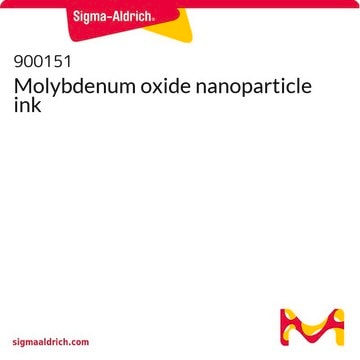793353
Tungsten oxide (WO3-x) nanoparticle ink
Synonym(s):
Avantama P-10, Nanograde P-10, Tungsten oxide nanoparticle dispersion, Tungsten oxide suspension, WO3 dispersion, WO3 ink
Sign Into View Organizational & Contract Pricing
All Photos(1)
About This Item
Linear Formula:
WO3-x
UNSPSC Code:
12352103
NACRES:
NA.23
Recommended Products
form
dispersion
Quality Level
concentration
2.5 wt. % in 2-propanol
particle size
<50 nm (BET)
density
0.7992 g/mL at 25 °C
Related Categories
General description
This WO3-x nanoparticle ink is for slot-dye, spin-coating and doctor blading for the use as hole transport layer in printed electronics. Tungsten oxide nanoparticle ink is a hole-selective interface layer ink based on a colloidal suspension of tungsten oxide (WO3) nanoparticles in isopropanol. The average size of WO3 particle is optimized around 12-16 nm. Tungsten oxide nanoparticle exhibits high work function, processability and easy layer formation on hydrophilic as well as hydrophobic substrates.This WO3-x nanoparticle ink is universally applicable in normal and inverted architecture solar cells.
Annealing temperature <100°C.
Annealing temperature <100°C.
Application
WO3 nanoparticle ink can be applied in OPV cells as hole extraction layer (HEL) materials. Tungsten oxide nanoparticle ink can be mixed with PEDOT:PSS formulations in order to fine tune electronic and morphological dry layer properties (e.g. conductivity, surface roughness or layer porosity).
Other Notes
Prior to application: Ultrasonicate and (optionally) filter through 0.45 μm PTFE filter
Working conditions: Application and film drying under nitrogen (or low humidity)
Post-treatment: Annealing of deposited WO3-x films at 80°C - 120°C
Working conditions: Application and film drying under nitrogen (or low humidity)
Post-treatment: Annealing of deposited WO3-x films at 80°C - 120°C
Legal Information
Product of Avantama Ltd.
Signal Word
Danger
Hazard Statements
Precautionary Statements
Hazard Classifications
Eye Irrit. 2 - Flam. Liq. 2 - STOT SE 3
Target Organs
Central nervous system
Storage Class Code
3 - Flammable liquids
WGK
WGK 1
Flash Point(F)
53.6 °F - closed cup
Flash Point(C)
12 °C - closed cup
Choose from one of the most recent versions:
Already Own This Product?
Find documentation for the products that you have recently purchased in the Document Library.
Customers Also Viewed
Inverted structure organic photovoltaic devices employing a low temperature solution processed WO3 anode buffer layer
Christoph J. Brabec; et al.
Organic Electronics, 13(11), 2479-2484 (2012)
High Fill Factor Polymer Solar Cells Incorporating a Low Temperature Solution Processed WO3 Hole Extraction Layer
Christoph J. Brabec; et al.
Advanced Energy Materials, 2, 1433-1438 (2012)
Lin Zhou et al.
Scientific reports, 9(1), 8778-8778 (2019-06-21)
This paper presents perovskite solar cells employed with WO3 nanoparticles embedded carbon top electrode. WO3 nanoparticles works as an inorganic hole-transport material (HTM) to promote the hole-extraction in the perovskite/carbon interface as revealed by efficiency, electrochemical impedance and external quantum
A universal method to form the equivalent ohmic contact for efficient solution-processed organic tandem solar cells
Journal of Material Chemistry A, 2, 14896?14902-14896?14902 (2014)
Flexible organic tandem solar modules with 6% efficiency: combining roll-to-roll compatible processing with high geometric fill factors
Energy & Environmental Science, 7, 3284?3290-3284?3290 (2014)
Our team of scientists has experience in all areas of research including Life Science, Material Science, Chemical Synthesis, Chromatography, Analytical and many others.
Contact Technical Service








